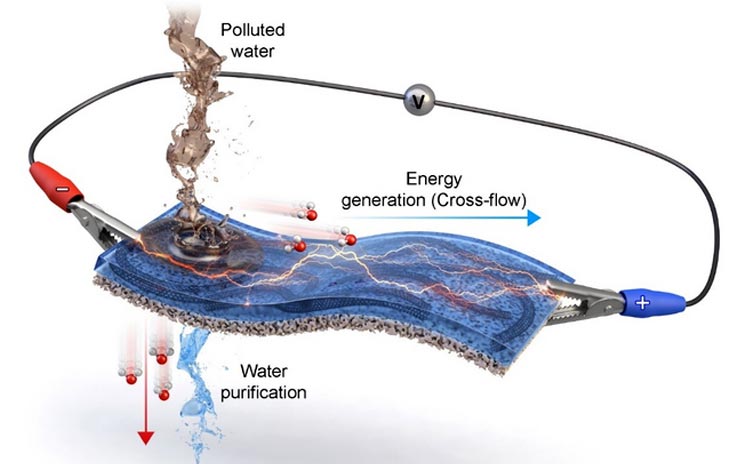Simultaneous electricity generation and filteration of wastewater

Schematic illustration for the operation of the electricity generation and water purification membrane developed by KIST-Myongji University joint research team
Credit: Korea Institute of Science and Technology
A novel membrane using a combination of a water filteration membrane and conductive polymer, Water quality improvement and continuous electricity generation using a simple operation method.
The purification of various water resources, such as rain, seawater, groundwater, river water, sewage, and wastewater, into potable or usable water is a high-energy process. So, what if electricity could be generated during the water purification process? In the spotlight, a domestic research team has developed a multifunctional membrane that can simultaneously generate electricity while purifying wastewater into drinking water.
The Korea Institute of Science and Technology (KIST, President Seok Jin Yoon) has announced that Dr. Ji-Soo Jang’s team from the Electronic Materials Research Center and Prof. Tae-Gwang Yoon’s team from the Department of Materials Science and Engineering, Myongji University (President Byeong-Jin Yoo) have jointly developed an advanced membrane that can simultaneously provide drinking water and generate continuous electricity from various water resources, such as sewage/wastewater, seawater, and groundwater.
The developed “sandwich-like” membrane is composed of a porous membrane that filters water at the bottom and a conductive polymer that generates electricity at the top. The membrane is designed to purify wastewater by controlling the direction of the water flow. Water flowing perpendicularly to the membrane generates direct current by the movement of ions along the horizontal direction. The membrane can reject more than 95% of the contaminants of sizes less than 10 nm (one hundred-millionth of a meter). Hence, microplastics and heavy metal particles in wastewater can be removed, and continuous electricity can be generated for more than 3 h with only 10 µl (microliter) of water.
Since the membrane can be manufactured using a simple printing process without size restrictions, it has a high potential to be commercialized due to low manufacturing costs and processing time. The research team is currently conducting follow-up research to generate electricity while improving the water quality of wastewater to the level of drinking water by developing the membrane for an actual factory. Dr. Ji-Soo Jang from KIST expressed his opinion on the research saying that, “As a novel technology that can solve water shortage problem and produce ecofriendly energy simultaneously, it also has great potential applications in the water quality management system and emergency power system.”
This research was conducted as a major project of KIST with the support of the Ministry of Science and ICT (Minister Jong-Ho Lee). These research findings were published in the latest issue of Advanced Materials, an international journal of materials (IF: 32.086, top 2.17% in the JCR field), and were selected to be on the front cover of the issue.
KIST was established in 1966 as the first government-funded research institute in Korea. KIST now strives to solve national and social challenges and secure growth engines through leading and innovative research. For more information, please visit KIST’s website at https://eng.kist.re.kr
Journal: Advanced Materials
DOI: 10.1002/adma.202209076
Article Title: Bidirectional water-stream behavior on multifunctional membrane for simultaneous energy generation and water purification
Article Publication Date: 9-Dec-2022
All latest news from the category: Materials Sciences
Materials management deals with the research, development, manufacturing and processing of raw and industrial materials. Key aspects here are biological and medical issues, which play an increasingly important role in this field.
innovations-report offers in-depth articles related to the development and application of materials and the structure and properties of new materials.
Newest articles

A universal framework for spatial biology
SpatialData is a freely accessible tool to unify and integrate data from different omics technologies accounting for spatial information, which can provide holistic insights into health and disease. Biological processes…

How complex biological processes arise
A $20 million grant from the U.S. National Science Foundation (NSF) will support the establishment and operation of the National Synthesis Center for Emergence in the Molecular and Cellular Sciences (NCEMS) at…

Airborne single-photon lidar system achieves high-resolution 3D imaging
Compact, low-power system opens doors for photon-efficient drone and satellite-based environmental monitoring and mapping. Researchers have developed a compact and lightweight single-photon airborne lidar system that can acquire high-resolution 3D…





















